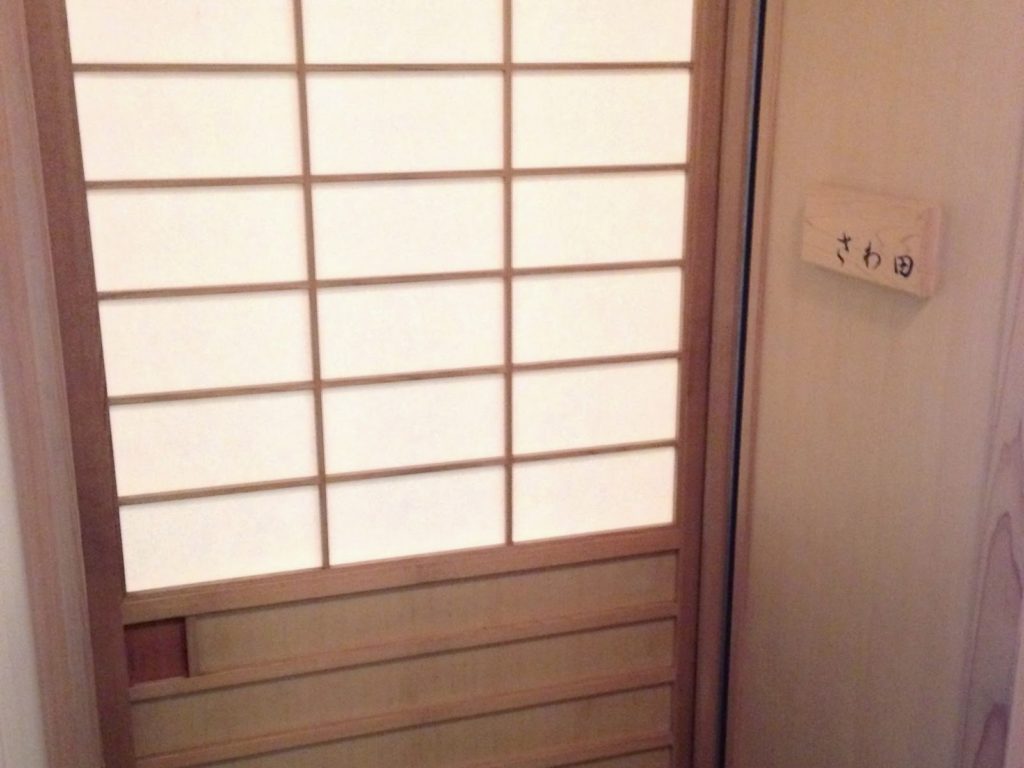
Sawada is a classic high end Tokyo sushi restaurant: a six seat counter manned by the chef himself, with one assistant (his wife, in this case).
We arrived just before noon, waiting on the tiny third floor landing outside the restaurant’s shoji door until Sawada-san’s wife slid it open to welcome us in.
A pale wood counter runs the length of the small room, with just enough space for six chairs on our side (and a shallow closet for coats and bags). The counter is bare except for a beautiful still life of vegetables in baskets on the left – wasabi roots, a selection of Japanese citrus, and tiny cherry tomatoes on the stem glistening like orange marbles.
There’s an old-fashioned looking icebox set into the back wall, and a simple shoji-covered window to the right. A narrow counter along the back left of the room contains the cooktop and grill.
And that’s it.
We chose to start with sashimi before moving on to sushi, and were joined by a couple from Mexico. Halfway through the meal, two solo diners joined for the sushi course only – a woman from Switzerland and a man who seemed to be a European expat.
I should note that the rules for dining at Sawada are simple: no photos, no perfume, and don’t be late.
To begin, Sawada-san set beautiful tiny dishes before each of us – one for soy sauce, one for wasabi, one for salt, and one for sudachi juice that we squeezed ourselves from the halved fruit he presented to us. He gestured at the combinations that are acceptable – sudachi juice and salt, for example, but not wasabi and soy sauce.
The first course he presented was cooked fava beans, skin sliced just a bit so they’re easy to slip out and dip in sudachi juice and salt. Simple but delicious. Sawada-san’s wife brought us sake (choices are light, medium, or “strong”).
Next the sashimi courses began. We had hirame, each piece flavored differently by the various options before us, and thin pieces of similarly mild white fish sliced from a wing of… something. Then wonderfully tender ika, abalone, red and purple uni served together, and torigai – a sort of large cockle that was in season. Sawada-san cut each into two parts, serving the first raw and passing the second to his wife to grill for us.
We had what he jokingly called “chu-otoro” – a cut of tuna from the collar that’s halfway between medium and fatty, served in a nori wrap with shredded daikon radish. And then otoro seared on the grill and cut into chunks, looking for all the world like steak dripping with fat. We had a palate cleanser after this of raw “water eggplant”, which had a flavor halfway between sweet and astringent. All the fish came from dark lacquered boxes, moved as needed from the icebox to the counter and back.
We each had a slice of a maki roll made with baby snapper, cucumber, shiso, and nanohana, a Japanese spring vegetable similar to broccoli rabe. Its yellow flowers are represented on the napkin we were given to take home.
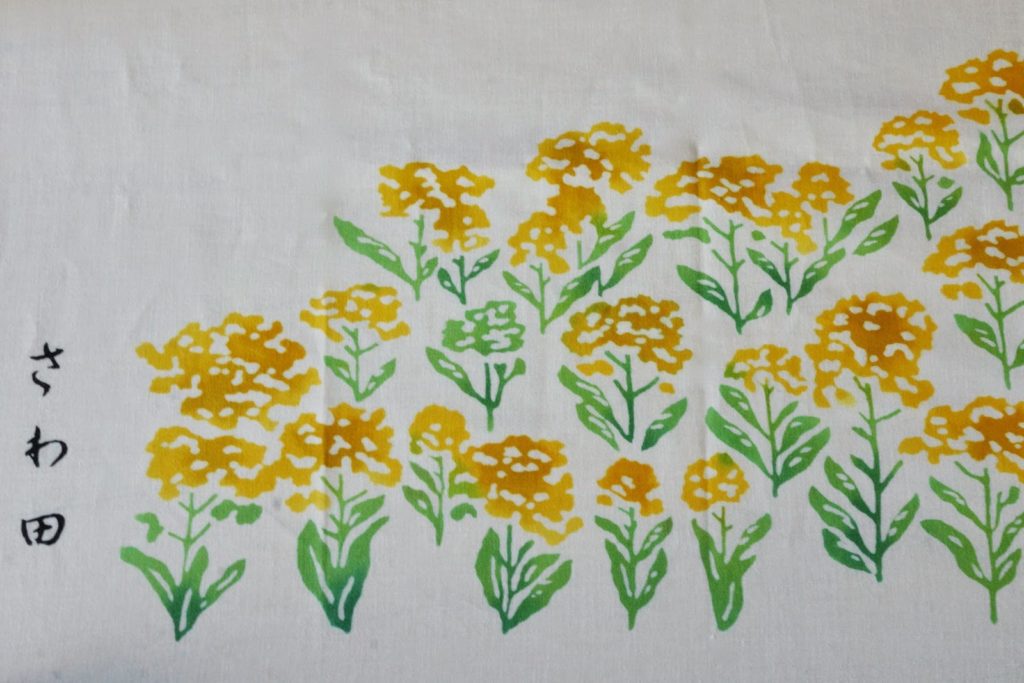
The last part of the sashimi course was shirasu (baby fish just a couple inches long) pressed between salted cherry leaves, a final seasonal salute.
Now we moved onto the sushi part of the meal. Sawara-san placed each piece on the counter directly in front of us, and we picked them up with our fingers and ate them immediately.
Of the things I remember: velvety smoked bonito and crisp, saline mirugai (geoduck), more chu-otoro, and kohada (pickled gizzard shad, a traditional Edo-style sushi), marinated akami tuna, hamaguri (cooked clam), ebi, and smoked sawara (Spanish mackerel) followed by a palate cleanser of the micro tomatoes. There were two kinds of otoro – raw and then broiled from above with coals held over the fish, and an unusual Edo-style piece consisting of cooked ika stuffed with a mixture of rice, tuna, nori, and sesame all chopped together.
We each received an enormous “gunkan” piece of uni sushi – a base of rice with a tall sheet of nori wrapped around to form a sort of container, into which Sawara-san spooned an incredible amount of Hokkaido uni (stored in its own seawater until ready to eat). This was one of my favorites; the sweet, fresh uni felt like the sort of thing you could only eat in Japan.
Finally, there were two kinds of anago, “sweet taste” and “salt taste”, and tamago.
Sawara-san asked if we wanted any more pieces but I was stuffed; in fact, I’d had to ask for slightly smaller rice portions midway through the meal. (There was no way I was going to stop eating early, though, and miss my favorites like uni and anago!)
For dessert, he handed each of us a single gooseberry still in its husk. We peeled back the papery skins and ate them unadorned. Despite the incredible attention paid to every element of our meal, the actual experience felt much the same – simple and pure, each bite made just for us and passed across the counter by the chef himself.
A special meal.
Reservations: Available on the first day of a month for anytime the following month (eg, March 1 for all April reservations). Reservations for tourists need to be made via hotel concierge and guaranteed by credit card. Note that Sawada is closed Mondays.
Tips on finding it: Use Google Maps; Sawada is on the third floor of a small building in a narrow alley in Ginza. The entrance is next door to the Del Rey Belgian chocolate shop, and you’ll see the Japanese script for “Sawada” on the sign next to the 3.

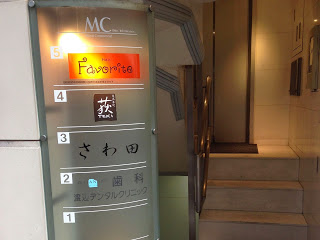
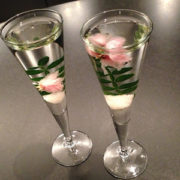 Aviary Kitchen Table: Autumn and Kyoto
Aviary Kitchen Table: Autumn and Kyoto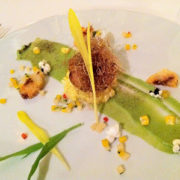 EL Ideas
EL Ideas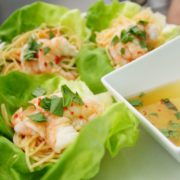 Lunch at Solbar, Calistoga CA
Lunch at Solbar, Calistoga CA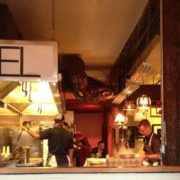 EL Ideas, Chicago
EL Ideas, Chicago
Wow. Of all of your various adventures I've read, I do believe this post wins for pure exotica and allure. It sounds like it was an amazing time.